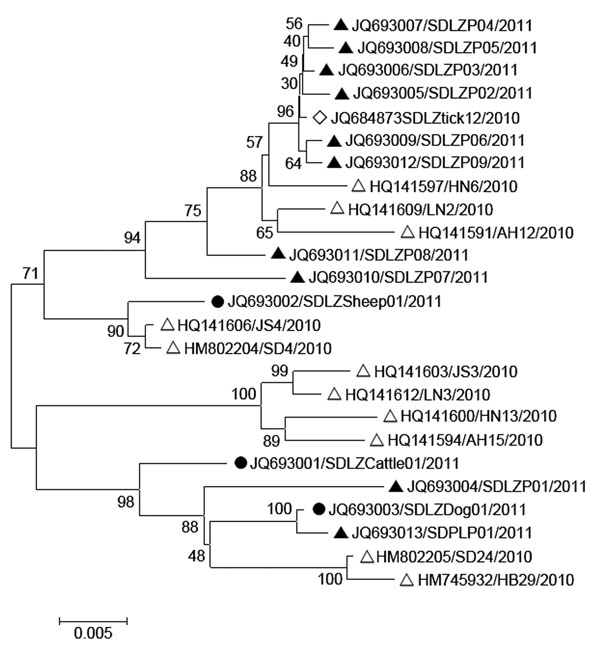Group Group V ((−)ssRNA) Family Bunyaviridae Higher classification Phlebovirus | Order Unassigned Genus Phlebovirus Rank Species | |
 | ||
Scientific name Severe fever with thrombocytopenia syndrome virus Similar Phlebovirus, Bunyaviridae, Haemaphysalis longicornis, Haemaphysalis, Amblyomma testudinarium | ||
Sfts virus
The SFTS virus (SFTS, Huaiyangshan virus) is a phlebovirus in the family Bunyaviridae. It appears to be more closely related to the Uukuniemi virus serogroup than to the Sandfly fever group. It is a member of the Bhanja virus serocomplex.
Contents
The clinical condition it causes is known as severe fever with thrombocytopenia syndrome (SFTS). SFTS is an emerging infectious disease recently described in northeast and central China. SFTS has a fatality rate of 12% and as high as 30% in some areas. The major clinical symptoms of SFTS are fever, vomiting, diarrhea, multiple organ failure, thrombocytopenia (low platelet count), leukopenia (low white blood cell count) and elevated liver enzyme levels.
History
In 2009 Xue-jie Yu and colleagues isolated the SFTS virus (SFTSV) from SFTS patients’ blood.
Genome
The genome has been sequenced. There are three segments — large (L), medium (M) and small (S) Six proteins have been identified — an RNA dependent RNA polymerase (RdRp), a glycoprotein precursor (M), a glycoprotein N (Gn), a glycoprotein C (Gc), a nuclear protein (NP) and a non structural protein (NSs).
The L segment encodes the RNA polymerase with 2084 amino acid residues.
The M segment encodes one open reading frame encoding 1073 amino acid precursors of glycoproteins (Gn and Gc).
The S segment has 1744 nucleotides of ambisense RNA encoding two proteins, the N and NSs proteins. These lie in opposite orientations and are separated by a 62 nucleotide intergenic region.
Evolution
Five genotypes (A-E) have been identified. Strains from China could be grouped into all five genotypes while isolates from South Korea lay in three (types A, D and E) and those from Japan only in one (type E). The virus appears to have originated in the Dabie Mountains in central China between 1918 and 1995.
Life cycle
The life cycle of the SFTSV is not yet known, but seems most likely to involve arthropod vectors and mammaliam hosts, including cats, mice, hedgehogs, weasels, brushtail possums and yaks. Humans appear to be accidental hosts, and play no essential role in the life cycle of SFTSV. SFTSV has been detected from the ixodid tick, Haemaphysalis longicornis, Ixodes nipponensis, Amblyomma testudinarium and Rhipicephalus microplus. The transmission route of SFTSV is unknown, but person to person transmission either plays no role, or at least is not an important route of transmission of SFTSV.
Epidemiology
This virus has been found in the Chinese provinces of Anhui, Henan, Hubei, Jiangsu, Liaoning and Shandong. SFTS occurs in rural areas, from March to November, and a majority of cases are found from April to July.
The virus has caused deaths in Korea and Japan.
